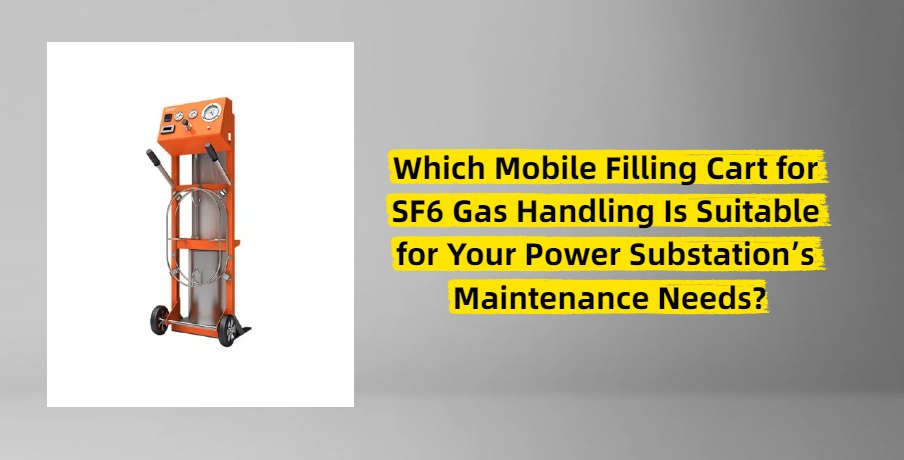
Which Mobile Filling Cart for SF6 Gas Handling Is Suitable for Your Power Substation’s Maintenance Needs?
SF6 gas (sulfur hexafluoride) is a critical insulation and arc-quenching medium in power systems, widely used in GIS (Gas-Insulated Switchgear), transformers, and circuit breakers. However, its efficient, safe, and compliant handling—especially during filling, replenishment, or maintenance—relies heavily on specialized equipment. The mobile filling cart for SF6 gas handling has emerged as a game-changer in this space, solving the limitations of fixed filling stations by enabling on-site, flexible operation. This guide breaks down its core value, key features, and how to choose the right model for your needs.
1. Core Features of a High-Quality Mobile Filling Cart for SF6 Gas Handling
A reliable mobile filling cart for SF6 gas handling is designed to address the unique challenges of SF6 management—precision, mobility, and safety. Here are its non-negotiable features:
- Precision Metering & Control: Equipped with high-precision flow meters (error ≤±1%) and digital pressure gauges, the cart ensures accurate SF6 filling volumes, avoiding overfilling (which risks equipment damage) or underfilling (which compromises insulation performance). Many models also include automatic shutoff valves to prevent human error.
- Enhanced Mobility: Built with heavy-duty casters (often anti-slip and lockable) and a compact frame, the cart can navigate narrow power substation aisles, uneven ground, or indoor/outdoor job sites. Some industrial-grade models add telescopic handles or forklift pockets for easy transport.
- Safety & Environmental Compliance: SF6 is a potent greenhouse gas, so top-tier carts integrate leak-proof hoses (PTFE-lined for chemical resistance) and built-in leak detectors to minimize emissions. They also meet global standards like IEC 60480 (SF6 handling guidelines) and EPA regulations, ensuring compliance with carbon reduction goals.
- Multi-Equipment Compatibility: With interchangeable connectors (e.g., DN15, DN20) and adjustable pressure ranges (0-1.6MPa or higher), the cart works with most SF6-powered devices, eliminating the need for multiple specialized tools.
2. Key Benefits of Using a Mobile SF6 Gas Filling Cart
Compared to fixed filling systems, the mobile filling cart for SF6 gas handling delivers tangible value for power utilities, industrial facilities, and maintenance teams:
- Boosted Operational Efficiency: On-site filling eliminates the need to transport heavy SF6 cylinders to fixed stations or move equipment to a filling area. This cuts downtime for critical power assets—often reducing maintenance time by 30-50%.
- Reduced Gas Waste: Precision control and leak-free design minimize SF6 loss. Studies show mobile carts reduce gas waste by up to 20% compared to manual filling, lowering both material costs and environmental impact.
- Improved Safety for Workers: Integrated safety features (e.g., pressure relief valves, anti-static grounding clips) protect operators from high-pressure hazards or gas exposure. The cart’s enclosed design also prevents direct contact with SF6, which can cause respiratory irritation if leaked.
- Cost Savings Over Time: While the initial investment is higher than manual tools, the cart’s durability (typically 8-10 years of service life) and reduced waste/ downtime lead to a fast ROI—often within 12-18 months for busy facilities.
3. How to Choose the Right Mobile Filling Cart for SF6 Gas Handling
Not all mobile carts are created equal. To select a model that aligns with your needs, focus on these criteria:
- Match Filling Capacity to Your Equipment: Calculate the typical SF6 volume of your devices (e.g., a 110kV GIS may require 50-100kg per filling). Choose a cart with a tank capacity (100L-500L) and flow rate (5-20kg/h) that meets your peak demand.
- Prioritize Mobility for Your Worksite: If you operate in outdoor substations with rough terrain, opt for carts with large-diameter pneumatic tires. For indoor use (e.g., data center GIS), a compact, low-noise model is better.
- Verify Certifications: Ensure the cart complies with local and international standards (e.g., CE for EU markets, UL for North America) and has third-party testing reports for leak rate and safety performance.
- Evaluate After-Sales Support: SF6 equipment requires regular calibration and maintenance. Choose manufacturers that offer on-site service, spare parts (e.g., hoses, filters), and calibration certificates to keep the cart in optimal condition.
4. Operation & Maintenance Best Practices
To maximize the lifespan and performance of your mobile filling cart for SF6 gas handling, follow these guidelines:
- Regular Calibration: Calibrate flow meters and pressure gauges every 6-12 months to maintain precision—uncalibrated tools can lead to incorrect filling and equipment failure.
- Leak Checks: Before each use, inspect hoses, connectors, and valves for cracks or wear. Use an SF6 leak detector to test for emissions; replace damaged parts immediately.
- Proper Storage: Store the cart in a dry, well-ventilated area away from direct sunlight. Drain any residual SF6 and clean hoses after use to prevent contamination.
- Operator Training: Ensure staff are trained on SF6 safety protocols (e.g., proper PPE use, emergency leak response) and the cart’s operation manual to avoid misuse.
5. Future Trends in Mobile SF6 Gas Handling Carts
As the power industry shifts toward sustainability and digitization, mobile filling carts for SF6 gas handling are evolving too:
- Smart Monitoring: New models integrate IoT sensors to track filling volume, pressure, and leak data in real time. This data is sent to a cloud platform, allowing remote oversight and predictive maintenance.
- Eco-Friendly Upgrades: Manufacturers are adding built-in SF6 recovery modules, turning the cart into a 2-in-1 tool for filling and recycling—aligning with global efforts to reduce SF6 emissions.
- Lightweight Materials: The use of aluminum alloys instead of steel reduces cart weight (by 15-20%) without sacrificing durability, making it easier to maneuver in tight spaces.
The mobile filling cart for SF6 gas handling is an indispensable tool for modern power systems, combining mobility, precision, and safety to streamline SF6 management. By understanding its core features, benefits, and selection criteria, you can choose a model that reduces costs, minimizes environmental impact, and keeps your critical equipment running reliably. For businesses looking to stay compliant and efficient, investing in a high-quality mobile SF6 filling cart is not just a choice—it’s a strategic necessity.

